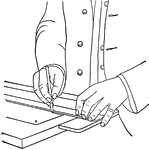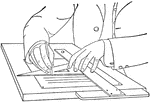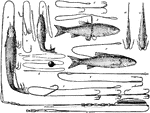Tapeworm
"The Tapeworm is an intestinal worm, Tænia solium, in form somewhat resembling tape. Its length…
!["The Tapeworm is an intestinal worm, Tænia solium, in form somewhat resembling tape. Its length is from 5 to 15 yards, and its breadth from two lines at the narrowest part to four or five at the other or broader extremity. At the narrow end is the head, which is terminated anteriorly by a central rostellum, surrounded by a crown of small recurved hooks, and behind them four suctorial depressions; then follow an immense number of segments, each full of microscopic ova. The segments are capable of being detached when mature, and reproducing the parasite. There is no mouth; but nutrition appears to take place through the tissues of the animal, as algæ derive nourishment from the sea water in which they float. The digestive system consists of two tubes or lateral canals, extending from the anterior to the posterior end of the body, and a transverse canal at the summit of each joint. [Pictured] A single segment or proglottis magnified; 1, generating pore; 2, water vessels; 3, dendritic ovary."—(Charles Leonard-Stuart, 1911)](https://etc.usf.edu/clipart/16500/16595/tapeworm2_16595_mth.gif)
Tapeworm
"The Tapeworm is an intestinal worm, Tænia solium, in form somewhat resembling tape. Its length…
!["The Tapeworm is an intestinal worm, Tænia solium, in form somewhat resembling tape. Its length is from 5 to 15 yards, and its breadth from two lines at the narrowest part to four or five at the other or broader extremity. At the narrow end is the head, which is terminated anteriorly by a central rostellum, surrounded by a crown of small recurved hooks, and behind them four suctorial depressions; then follow an immense number of segments, each full of microscopic ova. The segments are capable of being detached when mature, and reproducing the parasite. There is no mouth; but nutrition appears to take place through the tissues of the animal, as algæ derive nourishment from the sea water in which they float. The digestive system consists of two tubes or lateral canals, extending from the anterior to the posterior end of the body, and a transverse canal at the summit of each joint. [Pictured] Head of tænia solium (enlarged)."—(Charles Leonard-Stuart, 1911)](https://etc.usf.edu/clipart/16500/16599/tapeworm3_16599_mth.gif)
Tapeworm
"The Tapeworm is an intestinal worm, Tænia solium, in form somewhat resembling tape. Its length…
!["The Tapeworm is an intestinal worm, Tænia solium, in form somewhat resembling tape. Its length is from 5 to 15 yards, and its breadth from two lines at the narrowest part to four or five at the other or broader extremity. At the narrow end is the head, which is terminated anteriorly by a central rostellum, surrounded by a crown of small recurved hooks, and behind them four suctorial depressions; then follow an immense number of segments, each full of microscopic ova. The segments are capable of being detached when mature, and reproducing the parasite. There is no mouth; but nutrition appears to take place through the tissues of the animal, as algæ derive nourishment from the sea water in which they float. The digestive system consists of two tubes or lateral canals, extending from the anterior to the posterior end of the body, and a transverse canal at the summit of each joint. [Pictured] A, ovum with contained embryo, B, Cystericus longicollis."—(Charles Leonard-Stuart, 1911)](https://etc.usf.edu/clipart/16600/16600/tapeworm4_16600_mth.gif)
Tapeworm
"The Tapeworm is an intestinal worm, Tænia solium, in form somewhat resembling tape. Its length…

Parallelogram
"In the diagram, let AB and AC represent two forces acting upon the point, A. Draw the two dotted lines…
Visible spectrum
"A spectrum of sunlight is crossed by dark lines, many hundreds of whcih have been counted and accurately…
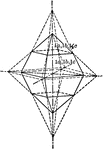
Sulphur crystal
"The forms present upon it are two pyramids of different slope but each intersecting all three of the…
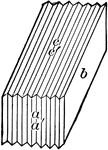
Albite
"Triclinic. Twinning very common, according to the albite law and evidenced by fine striation lines…

Bird Arteries
Arteries of the trunk of a bird. 1: The aorta. 2: The vena cava. 3: A cerebral artery. The small lines…
Greek Meander
A border design also known as the zigzag, the wave crest, or the water motif. It consists of a series…

Electricity
This illustration shows the field between two equally and oppositely charged spheres, mapped out by…
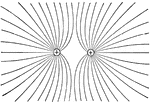
Electricity
This illustration represents the field between two equal positive charges; in this case the lines of…

Electricity
This illustration shows the lines of force when a positive charge equal to 4 at A, and a negative charge…

Electricity
This illustration shows the field of force between two parallel planes. At the edges its lines of foce…

Electricity
A is a positively charged conductor and B represents the equal and oppsite charge. When the conductor…
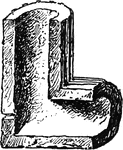
Corner-piece
A corner-piece to some stone conduit, carefully ornamented with projecting lines. Details that show…
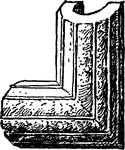
Corner-piece
A corner-piece to some stone conduit, carefully ornamented with projecting lines. Details that show…

Cube
"Science has succeeded in classifying the thousands of known crystals in six systems, to each of which…
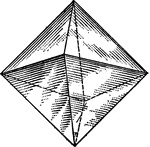
Regular Octahedron
"Science has succeeded in classifying the thousands of known crystals in six systems, to each of which…
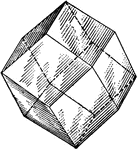
Rhombic Dodecahedron
"Science has succeeded in classifying the thousands of known crystals in six systems, to each of which…
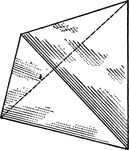
Regular Tetrahedron
"Science has succeeded in classifying the thousands of known crystals in six systems, to each of which…

First Right Square Prism
"Science has succeeded in classifying the thousands of known crystals in six systems, to each of which…

Second Right Square Prism
"Science has succeeded in classifying the thousands of known crystals in six systems, to each of which…

First Right Square Octahedron
"Science has succeeded in classifying the thousands of known crystals in six systems, to each of which…
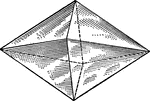
Second Right Square Octahedron
"Science has succeeded in classifying the thousands of known crystals in six systems, to each of which…

Hexagonal Prism
"Science has succeeded in classifying the thousands of known crystals in six systems, to each of which…

Six-sided Pyramid
"Science has succeeded in classifying the thousands of known crystals in six systems, to each of which…

Rhombohedron
"Science has succeeded in classifying the thousands of known crystals in six systems, to each of which…
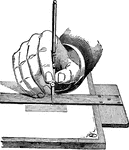
Ruling Pen
"For drawing ink lines other than arcs of circles, the ruling pen is used. It should be held as nearly…

Ruling Pen
"For drawing ink lines other than arcs of circles, the ruling pen is used. It should be held as nearly…
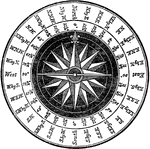
Compass Card
"Three principal parts, the card, the needle on its lower suface, and the case. The whole is enclosed…

Torsion Balance
"ABCD is a cylinder of glass 1 foot in diameter and 1 foot high. This cylinder is closed by a glass…

Glazing Barrel
"Glazing Barrels. A, elevation, showing door of case; C, hoppers for loading; B, section through barrel…
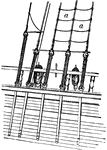
Ratlines
One of a series of small ropes or lines which transverse the shrouds horizontally, thus forming steps…
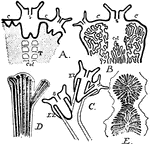
Stylophora Digitata
"A, Schematic longitudinal section through a zooid and bud of Stylophora digitata. In A, B, and C the…
Ruling Pen
A form of pen used for drawing lines of even thickness. It commonly consists of two blades which hold…

Camera Obscura
"Camera obscura strictly signifies a darkened chamber, because the room must be darkened, in order to…

Camera Obscura
"Camera obscura strictly signifies a darkened chamber, because the room must be darkened, in order to…

Longitude
"Let this figure represent the Earth, N being the north pole, S the south pole, and E W the equator.…
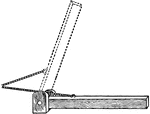
Oblique Pull
"It is worthy of note that, owing to the oblique direction in which the muscles are commonly inserted…
Muscle Diagram
"Diagram illustrating the muscles (drawn in thick black lines) which pass before and behind the joints…

Heart
"The heart and blood-vessels diagrammatically represented. L, lung; M, intestine; P, liver; dotted lines…
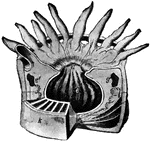
Anemone
"Sea anemone dissected; c, tentacles; d, mouth; e, stomach; white lines above k, the mesenteries." —Davison,…

Eye Diagram
Diagram of the eye. 1: Lines of light from end of arrow; 2: Small, inverted image in the eye.
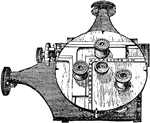
Micrometer
"A plate of glass about 2.5 inches square is ruled with twenty-one lines in one direction .1 inch apart,…

Horizontal Line Diagram
In this figure BB is the base line; HH the common horizontal or vanishing line; C…

Parallel Perspective
This figure represents the whole of the points and lines requisite for working out a drawing in "parallel…
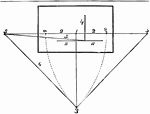
Angular Perspective
This figure comprises the whole of the points and lines preparatory to beginning a drawing in "angular…
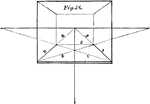
Parallel Perspective
The perspective shown in this plate is parallel perspective; and the subject here intended to be represented…

Angular Perspective
The perspective in this plate is "angular perspective," and the figure it represents is a flat square…
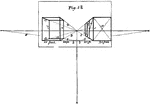
Parallel Perspective
Two upright oblong figures are here represented in parallel perspective. They may be imagined to resemble…

Angular Perspective
This object is a cube, having therefore all its faces of equal dimensions; and as both sides recede,…

Angular Perspective
This cube has four additional cubes of equal dimensions. This is effected by first drawing the cube…

Angular Perspective
This figure differs from the others because they are solid cubes. Further, the geometrical scale is…

